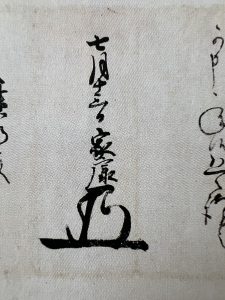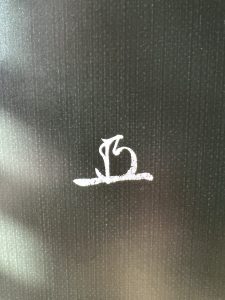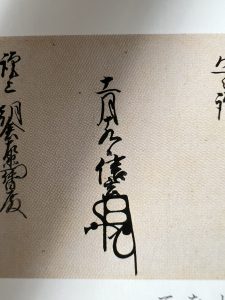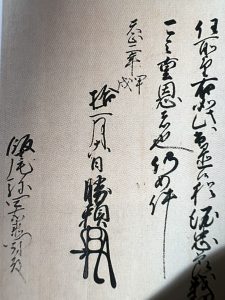徳川家康夏期特別展の続編、本日のつぶやきは「花押」についてです。(愛知県名古屋市千種区姫池通 骨董買取 古美術風光舎)
2023.09.07
みなさまこんにちは、スタッフYでございます。
先日より徳川美術館の徳川家康夏期特別展のつぶやきをしております。(この美術館についての詳細は昨日のブログを覗いてみてください。)徳川家康そして尾張徳川家の収蔵品をたっぷり楽しむことが出来ましたが、展示の中には数多くの書状が展示されておりました。
それにしても有名な刃や茶碗や調度品などを拝見することは、とにかく一目瞭然のすばらしさが誰の目にもすぐに伝わってくるのですが、書状については内容についての注釈がついてはおりますが、内容がわからないことにはその価値すらわかるはずもなく。この書状がすらすらと読めたのなら歴史学者の磯田道史先生みたいにもっと歴史の面白さや推理が広がるのだろうな…と、いつも実感いたします。
ですが、そんな書状があまり読めない自分でもすぐにわかるのはこの「花押」。(「華押」とも書きますが、本日は「花押」とさせていただきます)いつもの浅い好奇心で家康の花押はどこからきているものかなとちょっと調べてみたのですが、大変興味深かったです。
花押は重要な文書や、誰かにあてた手紙や、自分が描いた作品など様々なシーンにいれる「署名」なのですが、日本に中国では自分のサインを絵のようにデザインした「花押」というサインが存在いたします。花押は見ての通り特殊な形状をしており、他人は一朝一夕で真似をすることは難しく、その花押は自分が書いたと承諾したことを証明する役割を果たします。
そして書状を受けとった相手は、花押があるかないかでその書状が送り主本人からの正式なものかどうかを判別でき、すでに手元にある正式な花押と比較し、異なっていれば偽物と判断するようです。いわば本人を装った偽の書状(なりすまし)の防止のためであるのですが、まったく初めてもらう相手の書状の真偽はどうなるんだ?とちょっと疑問が残りますが、それはちょっと置いておくとしましょう。
これは、先日拝見した書状の徳川家康の花押

単体ですとこのような花押でして、シンブルですが、堂々とした風格を感じます。

花押はお家で代々引き継がれるパターンがあるようでして、調べていただくと代々よく似ております。徳川家も調べますとよく似ているのですが、最後の15代将軍慶喜だけは一切無視のちょっと凝ったものちょっと気になりました笑。
これらの花押、調べるとかなり沼りそうだったのですが、大まかに羽柴秀吉(豊臣秀吉)の「悉」や、織田信長の花押の1つに麟(きりん)を文字を使うパターンと、伊達政宗の花押で鳥の鶺鴒(せきれい)などの動物などの絵を使うパターンとがあるようです。どちらにしても大切な自分の分身のような「署名」ですので、どの武将や偉い方も意味を深く考え、そして偽装されぬように考えて考えて作っていることは伝わります。
とすると、この徳川家康の花押は文字?絵?の、どのくずしパターンなのか?と気になったのですが、ちょっと調べましたところ今川義元の花押と似ておりまして、たぶん義元の「義」のくずし文字だとのこと。幼少期身今川義元のもとに身を寄せていたことを鑑みますと、ありよりのありですね。

今川義元の花押
こちらが、今川義元の花押ですが、徳川家康の花押はこちらをシンプルにしたような花押。そして、この花押の元の文字は「義」ではないかと言われておりますが、こちらもまた辿っていきますとやはり室町時代から武家の花押は足利将軍家の花押の流れに従っていたようでして(足利家の花押も「義」をくずているかんじです。)歴代の将軍家へのリスペクトやあこがれもこうやって代々引き継がれるものなのでしょうね。

こちらは、武田信玄の花押。

武田勝頼の花押。こちらも一族で似ています。
お付き合いありがとうございました…。ほんの一部の搔い摘んだつぶやきになってしまいましたが、書状を読むことはハードルが高いとして、花押はちょっと面白そうですしなんとか解読できそうですね。今後書状をみる際の楽しみになるかと思いますので、ご興味のございます方は「花押」是非、いろいろ調べてみてくださいませ。
それにしてもこの「花押」の沼、かなり深かったです。
それではごきげんよう。
Hello everyone, this is Staff Y.
Since the other day, I have been tweeting about the Tokugawa Art Museum’s Tokugawa Ieyasu Summer Special Exhibition. (For more information about this museum, please take a peek at yesterday’s blog.) ) We were able to enjoy a lot of the collection of Tokugawa Ieyasu and the Owari Tokugawa family, and among the exhibits were a number of letters.
While viewing famous blades, teacups, and furnishings, one can easily understand the beauty of the items at a glance, the letters are annotated, but without knowing the contents, there is no way to understand their value. I always felt that if I could read the letter easily, I would be able to enjoy history more and expand my reasoning, just like the historian Mr. Michifumi Isoda.
However, even I, who cannot read such a letter very well, can easily recognize this “hanaseki” (flower stamp). (It is also written as “hanaoshi,” but I will use “hanasei” today.) With my usual shallow curiosity, I did a little research to see where Ieyasu’s hanasei came from, and it was interesting again.
Hanaseki is a signature that is placed on various occasions such as important documents, letters to someone, or works of art that you have painted, etc. In Japan and China, there is a signature called hanaseki, which is a pictorial design of your signature. As you can see, the hanaoshi has a special shape that is difficult for others to imitate overnight, and the hanaoshi serves as proof that you wrote it and that you agree with it.
The presence or absence of the haseki enables the recipient of a letter to determine whether the letter is from the sender himself or herself, and to compare it with the official haseki he or she already has on hand. The purpose of this system is to prevent a fake letter (spoofing), so to speak, but what about the authenticity of a letter from someone who is receiving it for the first time? But what about the authenticity of a letter from a person who is completely new to the company?
This is a hanaseki of Tokugawa Ieyasu from a letter I saw the other day.
It is a thimble, but I feel it has an imposing dignity.
It seems that hanaseki are handed down from generation to generation in a family, and if you check, you will find that they are similar from generation to generation. The Tokugawa family also has a similar pattern, but only the 15th shogun, Yoshinobu Yoshinobu, ignored all of them, which is a little elaborate and a little interesting.
I was almost swamped when I looked into these hanaseki, but it seems that there are roughly two types of hanaseki: “shikirin” of Hashiba Hideyoshi (Toyotomi Hideyoshi), one of Oda Nobunaga’s hanaseki that uses the character for “in” (Kirin), and one of Date Masamune’s hanaseki that uses pictures of animals such as “sekigaki” (wagtails). It was very interesting to research the matter, but it can be understood that all the generals and great men thought deeply about the meaning of their signatures, which are like their own alter egos, and thoughtfully created them so that they could not be disguised.
Then, is this hanaseki of Tokugawa Ieyasu a character or a picture? A picture? I was curious as to which kuzushi pattern is used for this hanaseki. I was curious about this, but after a little research, I found that it is similar to the hanaseki of Yoshimoto Imagawa, and is probably a kuzushi character of “righteousness” of Yoshimoto. Considering the fact that he lived with Imagawa Yoshimoto from his childhood, it is more plausible than not.
Hanaseki of Imagawa Yoshimoto
This is the hanaseki of Yoshimoto Imagawa, and the hanaseki of Ieyasu Tokugawa is a simplified version of this hanaseki. It is said that the original character of this hanaseki is “義” (meaning “righteousness”), and if we trace back the Hanaseki, we find that the Hanaseki of the samurai family has been following the Hanaseki of the Ashikaga shoguns since the Muromachi period (the Ashikaga Hanaseki also uses “義”). ) It seems that the respect and longing for the shoguns of successive generations was also passed down from generation to generation in this way.
This is a hanaseki of Shingen Takeda.
This is a hanaseki of Katsuyori Takeda. This one is also similar in the family.
Thank you for your time. I have only scratched the surface of what is written in these letters, but if you are interested in reading these letters, please take a look at “hanaseki” and see if you can decipher them, If you are interested, please check out the “hanaseki” in various ways.
I am still in the depths of this “hanaseki” swamp.
Good bye.
*******************
ご実家の整理やお片付けなどをされている方のご相談などが多くございます。
お片付けなどくれぐれもご無理のないようになさってくださいませ。
風光舎では古美術品や骨董品の他にも絵画や宝石、趣味のお品など様々なジャンルのものを買受しております。
お片付けをされていて、こういうものでもいいのかしらと迷われているものでも、どうぞお気軽にご相談下さいませ。
また風光舎は、出張買取も強化しております。ご近所はもちろん、愛知県内、岐阜県、三重県その他の県へも出張いたします。
まずは、お電話お待ちしております。
愛知県名古屋市千種区姫池通
骨董 買取【古美術 風光舎 名古屋店】
TEL052(734)8444
10:00-17:00 OPEN
#出張買取#骨董#古美術#骨董品#絵画#版画#茶道具#刀剣#彫刻

